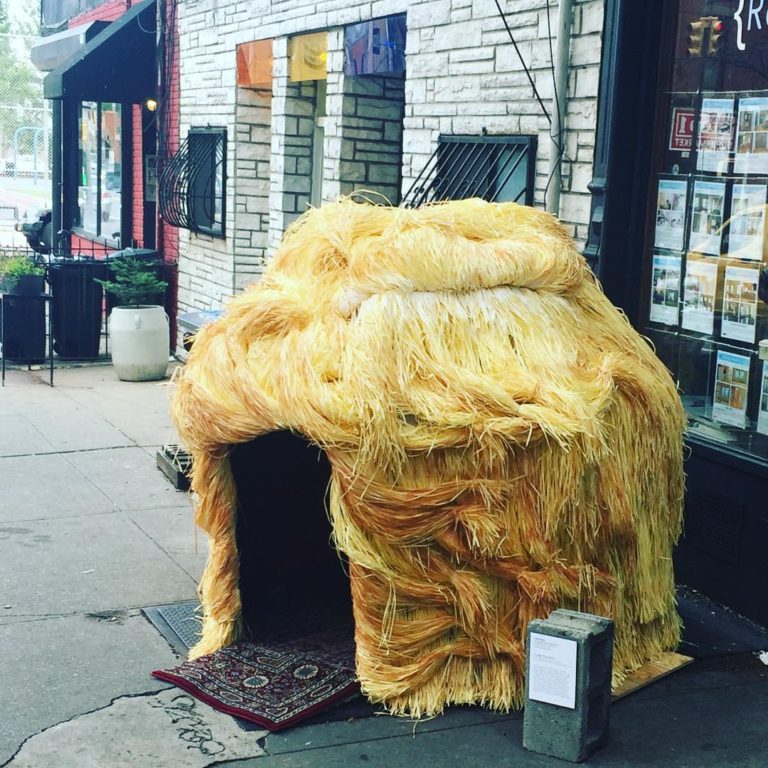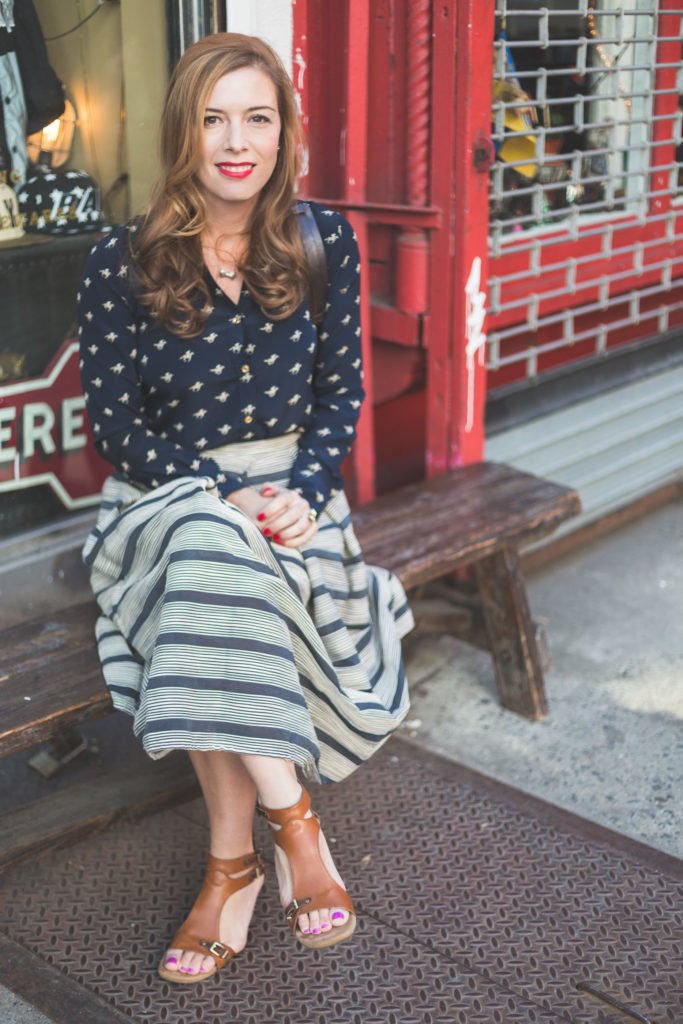An agent of change (and real estate): Victoria Hagman of Realty Collective
Feb 07, 2017 brooklyn based,brooklyn real estate,brooklyn realty,carroll garden,clinton hill,cobble hill,columbia waterfront,real estate agents,realty collective,red hook,victoria hagman

The Trump Hut outside of Realty Collective’s Red Hook office earlier this month. Photo: Sam Levinson
There are certain things you expect to see in the windows of real estate offices. Donald Trump’s hair is not one of them.
For the opening and closing of the group art exhibition, Gut Rehab, an installation of the Donald’s hair called the Trump Hut (which made an appearance at the Republican National Convention, along with Trump’s actual bouffant) was stationed on the sidewalk in front of the Red Hook office of Realty Collective, a boutique real estate agency owned by Victoria Hagman.
Its curator, Rachel Owens, gave artists a list of phrases to inspire work for the recent show, such as “Gentrification” “Occupation” “Real Estate” and “Sustainability,” and one of the resulting pieces was the Trump Hut, made from 98 hula skirts, solar powered lights, Ikea stools and a Champagne cooler. (Its creators were the same cultural pranksters responsible for the “Artisinal Landlord Price Hike Sale” campaign in bodegas like Jesse’s Deli that were slated to close due to rent hikes.)
Owens’ choice of subject matter and venue made perfect sense. Artists are a part of the gentrification process, pioneering cool and promise in formerly undesirable neighborhoods. And getting a real estate company to house an event that shines a light on development and displacement–the very things that real estate in New York City signifies–is a pretty poignant choice. The question, then, was what real estate company would actually agree to be the host.
In theory, Owens didn’t have to look very far. “Yes, Victoria and I are neighbors,” she admitted. “But I also know that Victoria has a real interest in the neighborhood and its community,” said Owens. “She has been here for several years and serves on neighborhood non-profit boards as well as the community board. I also knew that she had let other folks use the space for various other things. It’s a complicated issue and I know Victoria understands that.”
Their Red Hook office was a perfect gallery choice in another sense, given that Hagman was once on track to become a gallerist.

Victoria Hagman, founder of Realty Collective, historic preservationist, and an active member of Community Board 6.
When she first started in real estate 15 years ago, it had been a side gig, one that she fell into after a Craigslist ad asked two questions: Do you like architecture and meeting new people? (The answer to both was a very easy, Yes.)
Just as importantly, working as an agent allowed her to set her own hours so she could finish her art history degree as an undergrad. But the path she’d chosen in college became less appealing once she graduated.
“There’s a lot of snobbery in the art world,” said Hagman, who leaves curators like Owens out of this statement. “And I felt that I lost my appreciation for art by working in a museum or gallery.” The paltry starting salary didn’t help.
So she decided to save her aesthetic enjoyment for her off hours, and turned her side gig into self-employment. Together with a friend, Hagman founded her own real estate firm, Realty Collective, then became its sole owner when her friend moved on. The agency now has offices in three locations, Red Hook, Carroll Gardens and Bed-Stuy.
The flexibility of her work is still paying off, and ironically, afforded her the chance to pursue a master’s degree, this time in historic preservation at Pratt. Working through Brooklyn’s building boom turned her off to new condo developments along the waterfront, when there were so many existing structures that could be utilized for adapted reuse.
Up until grad school, Hagman says, “I was jaded. I thought, you can’t do anything in this city.” But Pratt “teaches students to be activists for preservation and activists for change, which is a good thing, because it turned me into an activist.
The final coursework of her historic preservation degree led Hagman far from home to Japan. While touring the island nation with her class, she marveled at how they didn’t divide neighborhoods into industrial and residential zones. “People live above and next to industry,” a model she wanted to see in Brooklyn.
She also learned just how ephemerally the Japanese must plan their cities, considering their frequent tsunamis and earthquakes. “It’s a country of disasters—everything is fleeting.” Then, within months of her return to her home in Red Hook, New York City experienced its greatest disaster in recent history.
A few things in Hagman’s life changed once Sandy ravaged Red Hook in October of 2011. Her home flooded. But her business had minimal damage. “I let our office on Van Brunt become a recovery center for small businesses, before Ikea reopened,” she said, flexing the activist muscle she developed at Pratt. Within that first month following the storm, “there was not a lot of guidance. No one knew what to do.” So she called upon a local architect who was familiar with the rebuilding of New Orleans after Katrina, to advise neighbors on how to rebuild resiliently in Red Hook. She also donated her storefront to Portside NY, a local non-profit that ran a relief operation for small businesses and residents from it. This is the work that earned Portside NY a Champions of Change award from the White House, an honor that Portside NY shared with Hagman.
Now, she’s frequently called upon to enact change, and serves on a long list of neighborhood committees within Community Board 6. One is Red Hook NY Rising, which is working with the New York City Economic Development Corp to build an integrated flood protection system for Red Hook, a federally funded, $100 million dollar project to examine how best to protect the Red Hook waterfront. NY Rising was allocated $3 million for other resiliency initiatives throughout Red Hook and Hagman worked with Pratt students and alumni who have “come up with some amazing, out-of-the-box ideas”—like creating a Resiliency BID and a Red Hook block that is actually a river, like a NYC version of Venice.
The most recent feather in her activist cap is creating the first-ever resiliency committee in New York City on a Community Board. Its purpose is to gather all the information on all resiliency and sustainability projects that are currently funded and share it with all the other waterfront neighborhoods like Coney Island or the Rockaways who would bear the brunt of another storm like Sandy. “Collective knowledge is a huge resource for communities faced with these challenges.”
Ultimately, being so in tune with the initiatives and agendas of the city’s planning commissions and landmark preservation boards has made her a better real estate agent. In a practical sense, she has experts and knowledge she can draw upon for those interested in buying within a historic district—contacts who know their way around renovating a landmarked home, and intel on many of the neighborhoods up for landmark consideration.
On a personal level, Hagman offers more than just deep knowledge of Brooklyn’s iconic neighborhoods.
“We’re grounded and down-to-earth people who want to help people get through this stressful process of buying a home. And the dollars that we do collect go back into the community. Most people see brokers as the enemies of the community, but we’re part of the community and we want to see the whole community flourish. It’s much more engaging for us to help and work with people to make a difference.”
See piece in Brooklyn Based here.












